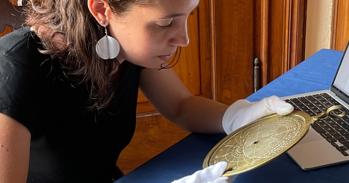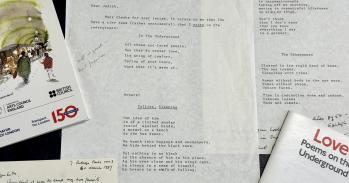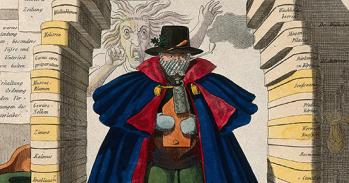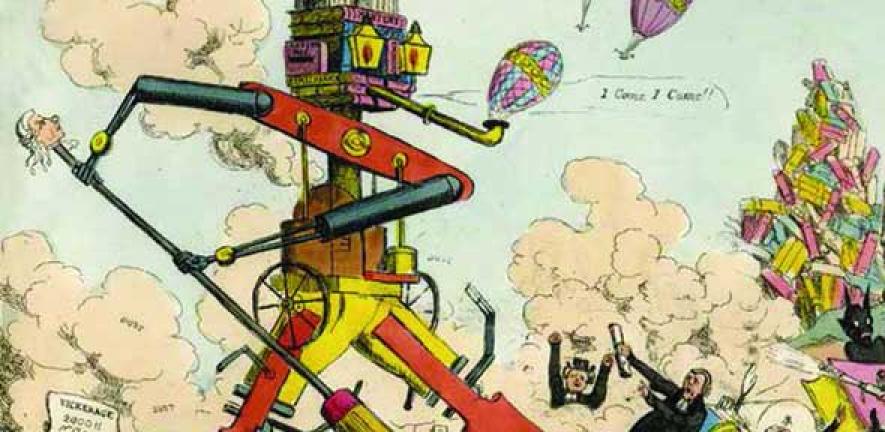
In his latest book, Professor Jim Secord explores seven scientific books that made a lasting historical impact. Visions of Science concentrates on the 1830s, an era that witnessed an often passionate clash of viewpoints. Secord will be talking about his book in Heffers bookshop tonight (17 April 2014).
In his latest book, Professor Jim Secord explores seven scientific books that made a lasting historical impact. Visions of Science concentrates on the 1830s, an era that witnessed an often passionate clash of viewpoints. Secord will be talking about his book in Heffers bookshop tonight (17 April 2014).
The great merit of the Principles of Geology was that it altered the whole tone of one’s mind and therefore that, when seeing a thing never seen by Lyell, one yet saw it partially through his eyes.
Charles Darwin
In the first half of the 19th century science was not a profession but a vocation. Today, for many, it is both. Jim Secord is best known in Cambridge and beyond for his role as Professor of History and Philosophy of Science, and as Director of the Darwin Correspondence Project which makes available online and in print the full texts of Charles Darwin’s letters.
Secord has devoted much of his academic life to investigating the early 19th century as a critical juncture in the narrative of science. His latest book, Visions of Science: Books and readers at the dawn of the Victorian age, looks at the intellectual life of Britain in the 1830s when a number of notably brave individuals were beginning to question ever more insistently the established political, religious and social order.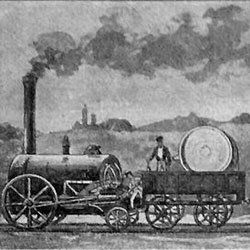
Visions of Science explores the extraordinary and lasting impact of scientific books first published in the decade that began with the opening of the first railway, connecting Manchester to Liverpool. In an accessible style, and with a scholarly grasp of his protagonists, Secord examines seven works which recast the way that science was understood, setting their trajectories within a cultural and social context still dominated by a strongly Christian viewpoint.
Humphry Davy, remembered as inventor of the Davy lamp, wrote Consolations in Travel, a voyage of discovery through the history of humanity in the format of a dialogue between the narrator and a spirit called the Genius. Creator of what has been described as the world’s first computer, Charles Babbage is author of Reflections of the Decline of Science in England, which shocked readers with its picture of an unthinking society failing to support scientific endeavour.
In his Preliminary Discourse on the Study of Natural Philosophy, John Herschel struck out against publishing convention with a book that was cheaply produced and flimsily bound. As a believer in the transformative power of education, Herschel’s text addressed his readers as fellow practitioners, encouraging them to study nature for themselves.
Mary Somerville’s On the Connexion of the Physical Sciences sought to bring together for the public the common bonds within the sciences at a time when the different disciplines were developing boundaries. In Principles of Geology, Charles Lyell laid the foundations for the modern study of the Earth. Charles Darwin wrote: “The great merit of the Principles was that it altered the whole tone of one’s mind and therefore that, when seeing a thing never seen by Lyell, one yet saw it partially through his eyes.” Lyell, however, never fully accepted Darwin’s theory of evolution.
Lawyer and lecturer George Combe used his book, Constitution of Man, first produced as a limited edition and then as the first in a series of inexpensive “People’s Editions”, to apply scientific methods to tackle questions about the human mind that had been asked for thousands of years by applying scientific methods. Combe was an ardent proponent of phrenology, a way of seeing the brain divided into different ‘organs’, each one responsible for an aspect of behaviour. Long since discredited as quackery, phrenology made significant inroads by challenging accepted thinking about the relationship between mind and body.
Thomas Carlyle’s Sartor Resartus is a delightfully wicked and knowing satire of the learned (and earnest) reflections published in the early 19th century. Carlyle’s satire proposed in suitably high-flown prose a scientific analysis of clothes as the outward and most visible signs of character. Sartor Resartus both amused and infuriated readers; many were simply baffled by its complexity and the apparent absurdity of its narrative. Its significance lay in its power to make readers think much more critically and see sciences as something dynamic rather than mechanic. The geologist Joseph Beete Jukes declared that Carlyle had driven a “good broad harpoon deep into the sweltering side of the floating carcass of Humbug”.
Secord describes the context in which these books engaged with fundamental questions about the world around them and the potential it offered. With the invention of the steam engine, the limitless possibilities of machines were opening up. The year 2000, as imagined in a lithograph published in Everybody’s Album & Caricature Magazine, featured an  aerostation, moveable houses and perpetual motion. New institutions emerged, including the gloriously named (and widely ridiculed) Society for the Diffusion of Useful Knowledge. Cheap paper, machine printing and penny libraries gave increasing numbers of ordinary working people access to books.
aerostation, moveable houses and perpetual motion. New institutions emerged, including the gloriously named (and widely ridiculed) Society for the Diffusion of Useful Knowledge. Cheap paper, machine printing and penny libraries gave increasing numbers of ordinary working people access to books.
But the onward march of democratisation in reading was not universally welcomed. Learned societies set up to make books more freely available were mocked by the Tories as Whig (Liberal) follies. The public, shaken by the violent revolutions that had occurred across the English Channel, were alarmed by universal literacy as a concept. A rigid class structure, rotten boroughs and a suffrage system that limited voting to just 400,000 people from a population of 14 million meant that the reins of power were firmly gripped by the privileged few.
In 1830 universal votes for women were almost a century into the future, and girls’ education was limited. The daunting odds stacked against women scientists makes Secord’s account of the achievements of Mary Somerville in mathematics and the wider sciences even more compelling. Her name honoured by Oxford’s first college for women, Somerville was encouraged in her study of maths by her family, though her mother feared a passion for abstract maths might lead to madness, and by her second husband who, as a wedding gift, encouraged her to buy a selection of advanced and costly mathematical books. These books are now in the library of Girton College.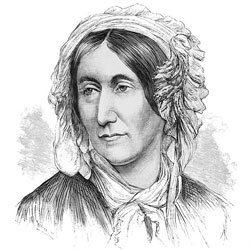
Towards the end of her life, Somerville recalled the power and potential that these books represented: “I was thirty-three years of age when I bought this excellent little library. I could hardly believe that I possessed such a treasure when I looked back upon the day that I first saw the mysterious word ‘Algebra’.”
In his epilogue to Visions of Science Secord notes that it is hard to recapture the intense enthusiasm felt for the new literature of science in the early industrial age. The example he gives to fill that gap is touching: on seeing the first number of the Society for the Diffusion of Useful Knowledge’s Penny Magazine in the window of a shop, farmboy James Croll bought a copy and embarked on a lifetime of study. Croll used the magazine to read widely on astronomy and natural philosophy, becoming a leading authority on cosmology while working as a caretaker.
Secord will be talking about Visions of Science in Heffers Bookshop, Cambridge, tonight (Thursday 17 April 2014). Doors open 6.30pm. Tickets from: https://james-secord.eventbrite.co.uk/
Visions of Science: Books and Readers at the Dawn of the Victorian Age by James A. Secord is published by Oxford University Press.
Inset images: The first passenger carriage in Europe, 1830, George Stephenson´s steam locomotive, Liverpool and Manchester Railway; Difference Engine No.1 (Partial Model) Charles Babbage. Science Museum, London; Penny Magazine of the Society for the Diffusion of Useful Knowledge, October 27, 1832. Published in London by Charles Knight; Mary Somerville, 1884. All images: Wikimedia Creative Commons.
This work is licensed under a Creative Commons Licence. If you use this content on your site please link back to this page.


